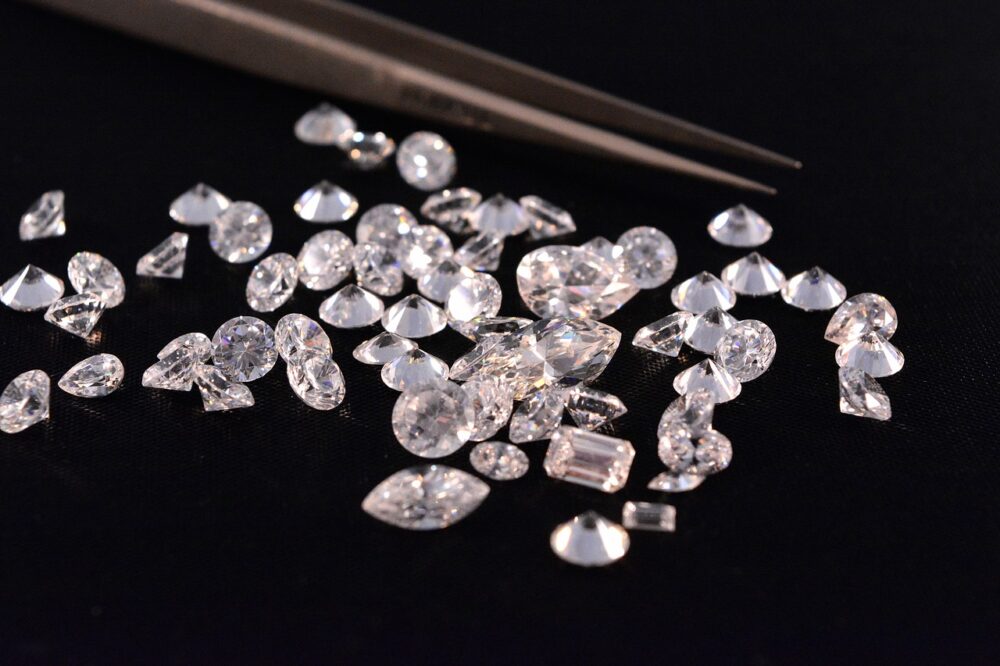Each of the 4 C’s of diamonds (Cut, Color, Clarity and Carat) play a role in a diamond’s beauty. The grades a diamond carries in these four areas give a clear idea of the diamond’s quality, and by extension the right price you should be willing to pay.
A diamond’s quality is determined by the 4C’s:
- Cut: Quality of the angles, proportions, facets, and finishing details.
- Color: How colorless the diamond is.
- Clarity: How clean the diamond is of inclusions and blemishes.
- Carat: The weight of the diamond.
These four qualities of a diamond are the key components that impact its beauty and structure. The 4C’s interact with each other within the diamond. They dictate how the diamond appears and how high quality it is. As an example, the diamond’s ability to reflect light back to your eyes depends primarily on cut quality but also on color and clarity.
The four diamond characteristics are graded by professionals on a consistent scale, giving you a tool to evaluate diamonds. By reviewing the 4C’s of a particular diamond, you can better determine if the diamond is of high-quality. GIA explains why and how diamond grades got created.
The Characteristics of Diamonds
The GIA and the AGS are the prominent institutions with a sophisticated grading system for evaluating diamond characteristics. They are the most consistent entities and the ones we recommend gaining a diamond certificate from. Each of the C’s are graded on a scale, and can be evaluated for quality. Though some universal terminology and standard grading exists, it does vary by lab entity.
Gradings of the 4 C’s help determine the value of a diamond and indicate its quality. Diamond sellers often set their prices based on grading reports. Knowing the basics of these gradings is helpful when comparing two similar diamonds, but what remains most important is how the diamond appears to the naked eye—and how attractive the diamond is overall. In this sense, having a foundational understanding of the 4 C’s is imperative as a buyer, so that you can avoid spending your budget on a component that will go unnoticed.
Diamond Quality
The 4 C’s of diamonds gives you a more objective way to measure and assess the quality of a diamond. Without the 4 C’s, diamond quality is something that is hard to quantify. Any unscrupulous vendor could easily claim a diamond to be high-quality, and thus charge more than it’s worth.
It becomes a lot easier on consumers with a more objective guide on what makes a diamond high or low-quality. Each of the 4 C’s offers a quantifiable description of its quality in certain areas, in turn making it easier to judge whether or not it’s worth its price tag.
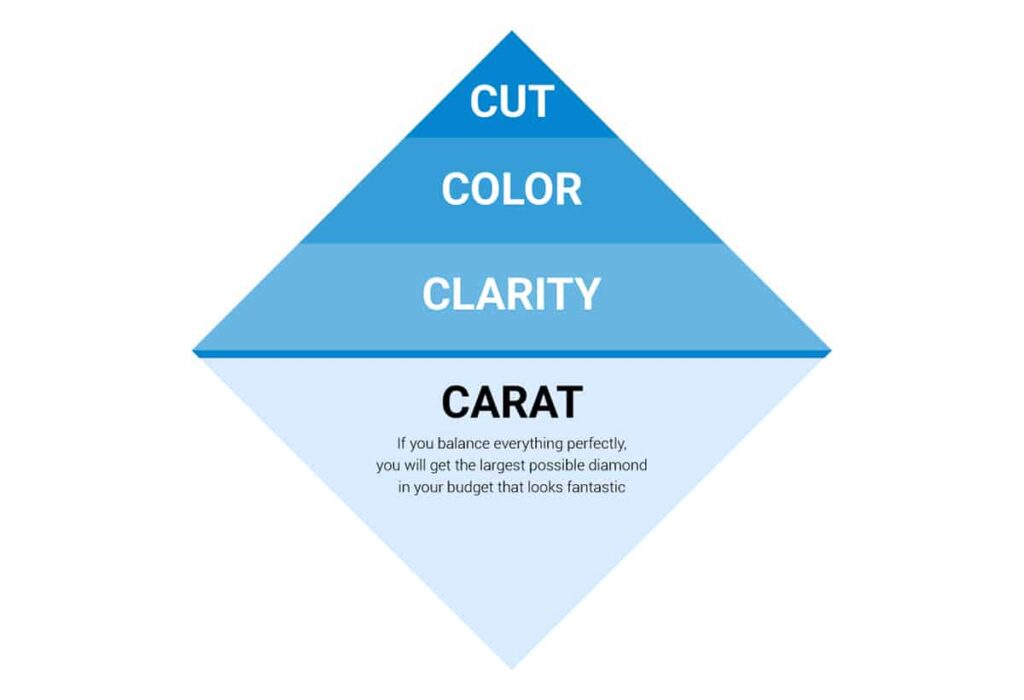
Cut
The ‘Cut’ is perhaps the most important aspect of a diamond quality that impacts a diamond’s beauty. Diamond Cut specifically refers to the quality of a diamond’s angles, proportions, symmetrical facets, brilliance, fire, scintillation and finishing details. These factors directly impact a diamond’s ability to sparkle, along with its overall aesthetic appeal.
The GIA diamond cut chart grades Diamond Cut on the scale of Ideal, Excellent, Very Good, Good, Fair and Poor. The Ideal and Excellent grades, depending on Diamond Shape, signify proportions and angles cut for maximum brilliance and fire.
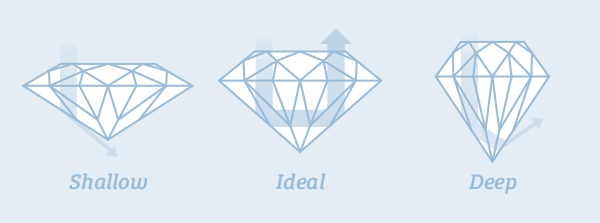
Even if two diamonds are given the same grade on the diamond cut chart, cuts vary significantly among diamonds and diamond cutters. At times, a cutter may aim for maximum Carat weight, leaving the diamond too deep or too shallow for optimal light reflection. Other times a diamond may be cut to minimize the number of inclusions, improving its Clarity, but forgoing maximum sparkle. Even an Ideal cut diamond may have a yellow tint that is too noticeable and detracts from the gem’s beauty.
More importantly, though, is ensuring Cut is a focal point of your diamond selection. Even a pristine 2 Carat Diamond with no blemishes or color tinting can be dull if it’s not cut exceptionally well. Cut is the biggest indicator of beauty, and should be made priority over the other C’s.
It’s essential to note that a top grade designation on the diamond cut chart, such as Excellent, doesn’t necessarily indicate an outstanding diamond cut. Almost 55% of all diamonds sold online are Excellent cuts. Some are stunning, while others are mediocre.
Also, you might have heard about triple ex diamonds (excellent cut, polish and symmetry). A lot of people think that these diamonds are worth the premium some jewellers are charging but the reality is a bit different.
Because Cut is so important to a diamond’s fundamental beauty, it’s crucial to review a diamond’s Cut carefully and ask for the eye of an expert.
Color
Diamond Color is graded in terms of how white or colorless a diamond is. The GIA grades diamonds from D to Z, with D being the most colorless, and Z containing noticeable brown or yellow tint. The diamond color chart below shows how each grade looks next to each other.
While the diamond color chart provides an example of how each grade appears, it’s important to look at each diamond individually. Depending on the diamond’s cut, carat weight and shape, the color might appear different among diamonds.
The pricing of diamonds usually reflects the grade—sometimes significantly. In most cases, the naked eye cannot tell the difference between two adjacent color graded diamonds, though the price difference may be significant.
The most critical aspect with Color is to determine if it appears colorless in relation to its setting. You also want to be certain that a diamond is clear of any tinting that takes away or interferes with white and colored light reflections.
Brilliance, or sparkle, is created from the way the diamond is cut. It is not advantageous to purchase a diamond that distracts from this important principal characteristic.
As a general recommendation, review each diamond closely and ask for the assistance of an expert. This is the best way to ensure you’re not paying for a feature (i.e. too high of Color grade) that will go unnoticed, or purchasing a diamond that distracts or interferes with light reflection.
Note: Certain colored diamonds are valued stones, like a fancy pink or green diamond. Color grades for these diamonds are distinctly different from traditional “white” diamonds and don’t appear on the diamond color chart.
Diamond Color Chart
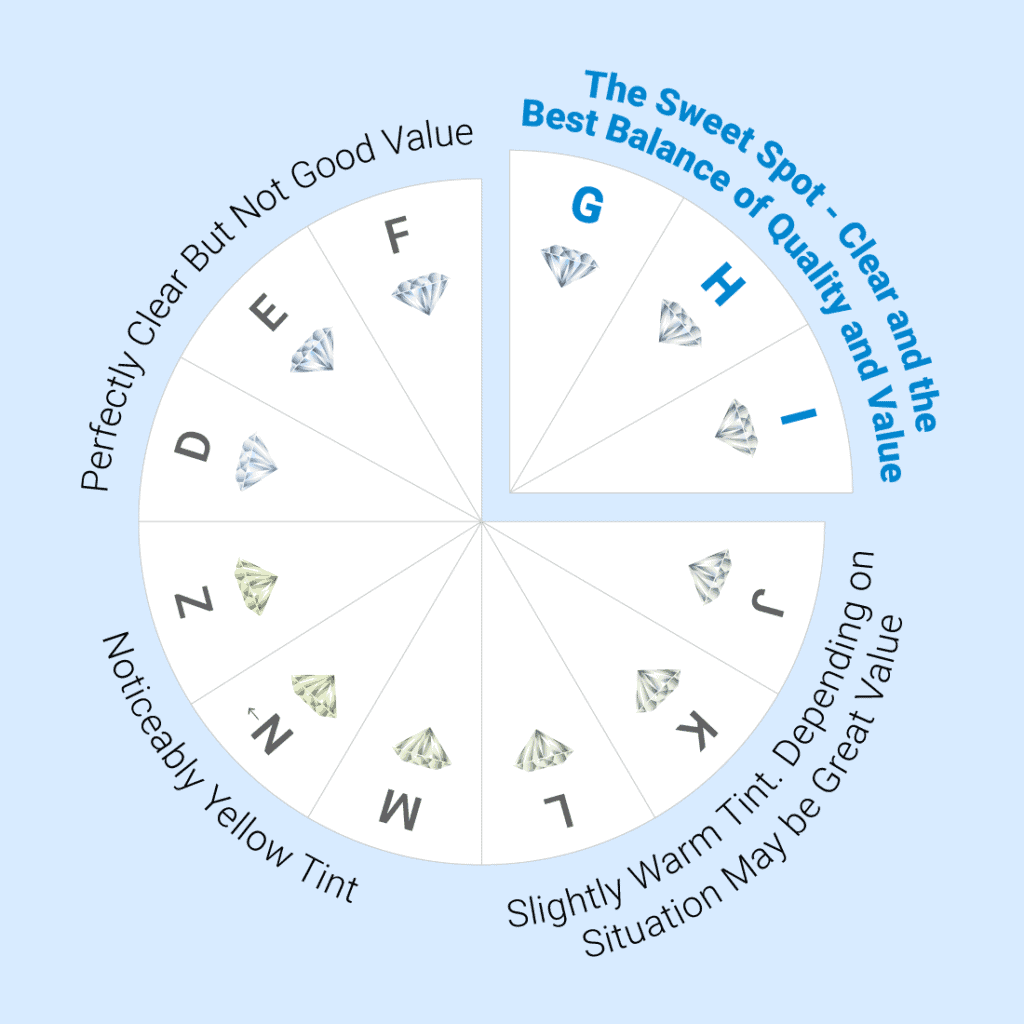
Clarity
A Diamond’s Clarity grade evaluates how clean a diamond is from both inclusions and blemishes. Clarity is graded by the GIA on the following diamond clarity chart:
- FL (Flawless)
- IF (Internally Flawless)
- VVS1 (Very, Very Slightly Included 1)
- VVS2 (Very, Very Slightly Included 2)
- VS1 (Very Slightly Included 1)
- VS2 (Very Slightly Included 2)
- SI1 (Slightly Included 1)
- SI2 (Slightly Included 2)
- I1 (Inclusions 1)
- I2 (Inclusions 2)
Note that each diamond differs slightly. Rather than sticking to a particular grade on the diamond clarity chart, review each diamond to see if you notice imperfections.
Diamond Clarity Chart
This diamond clarity grading scale shows and sums up each clarity grade. Watch how the visibility of the inclusions changes in the image on the right.
As you work your way across the diamond clarity chart, you’ll notice how more inclusions and blemishes are visible. Not all imperfections are visible to the naked eye, though. That’s why it’s important to look at each individual diamond.
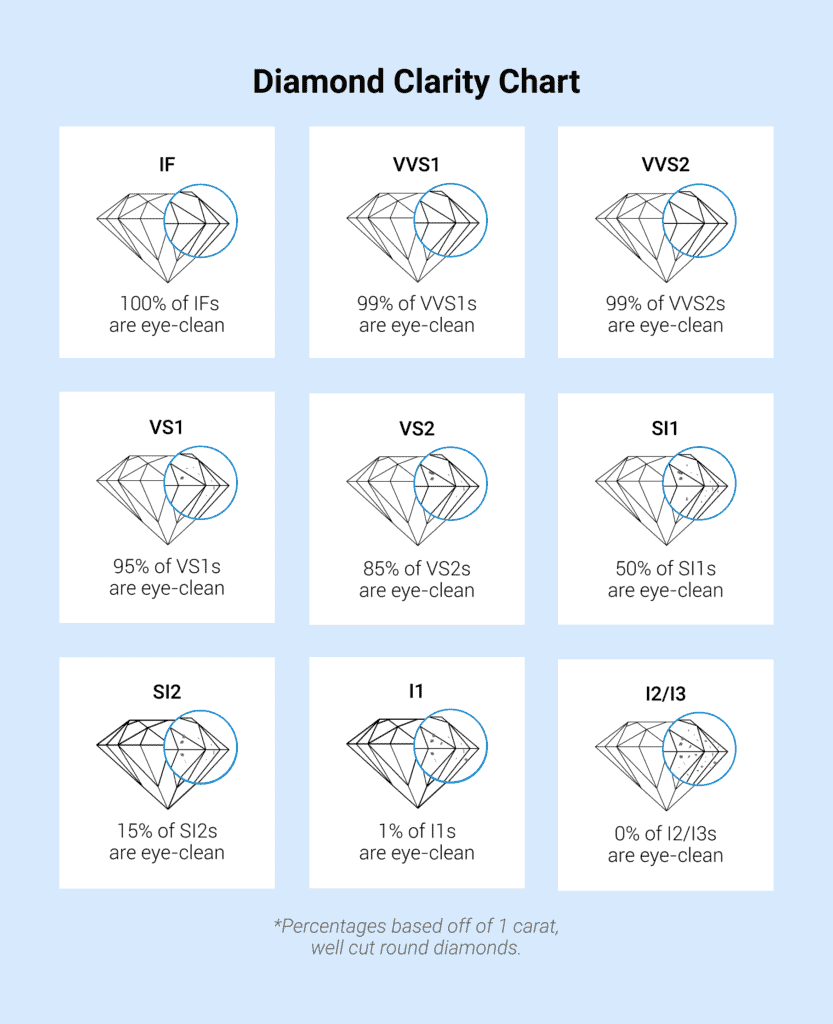
Depending on the size, location and darkness of blemishes and inclusions, these imperfections can interfere with light as it passes through the diamond. When this happens, the brilliance and beauty of the diamond is dulled, taking away from the high-quality Cut.
For Clarity, our primary recommendation is to ensure the diamond is eye clean, and that inclusions are not interfering with light reflection.
Review the stone to see if it is eye clean and ask for confirmation from an expert. A certificate alone won’t tell you how a diamond’s blemishes will impact the stone’s appearance and brilliance.
Eye-Cleanliness is Paramount
In our opinion, a consumer’s goal should be to find the cheapest (in regards to clarity; other factors matter as well) “eye-clean” diamond you can find. We use “eye-clean” to describe diamonds that may have inclusions if you look at them with a magnifying glass (or microscope or loupe), but the typical person can’t see the inclusion with their naked eye.
Carat Weight
Often when people hear the term “Carat Weight,” they think it refers to the size of the diamond. In actuality, Carat refers to the weight of the diamond, not how large the stone is. A 1 Carat Diamond equals 200 milligrams, or 0.2 grams—and weighs about the same as a quarter of a raisin. Depending on the Diamond Shape and how it is cut, two 1 Carat Diamonds might be quite different in size.
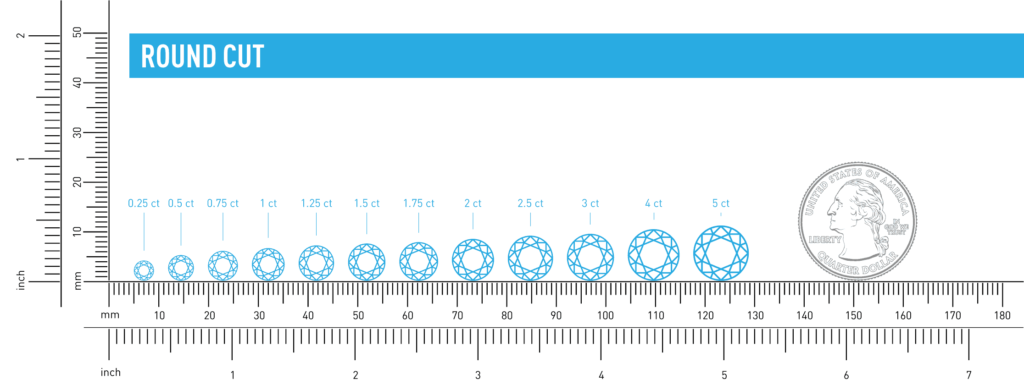
While Carat weight is an element to consider when buying a diamond, the overall appearance and brilliance should carry more importance. For example, a mediocre 1.5 Carat diamond will not shine as brightly—or draw as much attention—as a stunning 1.0 Carat diamond, no matter how much more it weighs. Rather than sticking to a certain number on the diamond carat weight chart, choose a diamond with an Excellent cut or Ideal cut in the shape you desire.
How the 4 C’s work together
Each of the 4 C’s contribute to the overall beauty of a diamond and make each stone unique. A Diamond, however, should be viewed as an organic whole. Because the eye has difficulty differentiating one diamond characteristic by itself, such as Clarity or Color, it is important to consider how the 4 C’s impact each other.
Which is the most important of the four C’s?
- Cut: The most important of all the diamond characteristics as it most readily impacts a diamond’s beauty. Look for high levels of brilliance and fire, and be willing to reduce your spending in other areas like Clarity or Color to ensure an exceptional Cut.
- Color: The second most important aspect to focus on. A diamond should look white or colorless to the naked eye. Ensure the Color does not distract or interfere with white and colored light reflection.
- Clarity: The third most important characteristic on the list. Choose a diamond that is eye clean. Blemishes and inclusions should not distract from the brilliance or fire of a diamond.
- Carat: Last but not least. Based on how you balanced out the other 3 C’s that will determine how large of a diamond you will end up with. If you balance everything perfectly, you will get the largest possible diamond in your budget that looks fantastic.
With these fundamentals in mind, remember that a diamond is a precious whole, and should be looked at in totality. The four main qualities of a diamond all play an important role in how the diamond looks.

